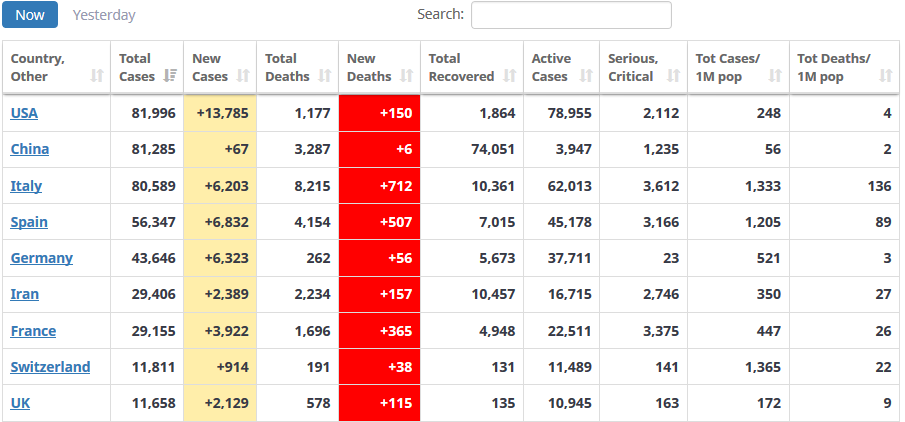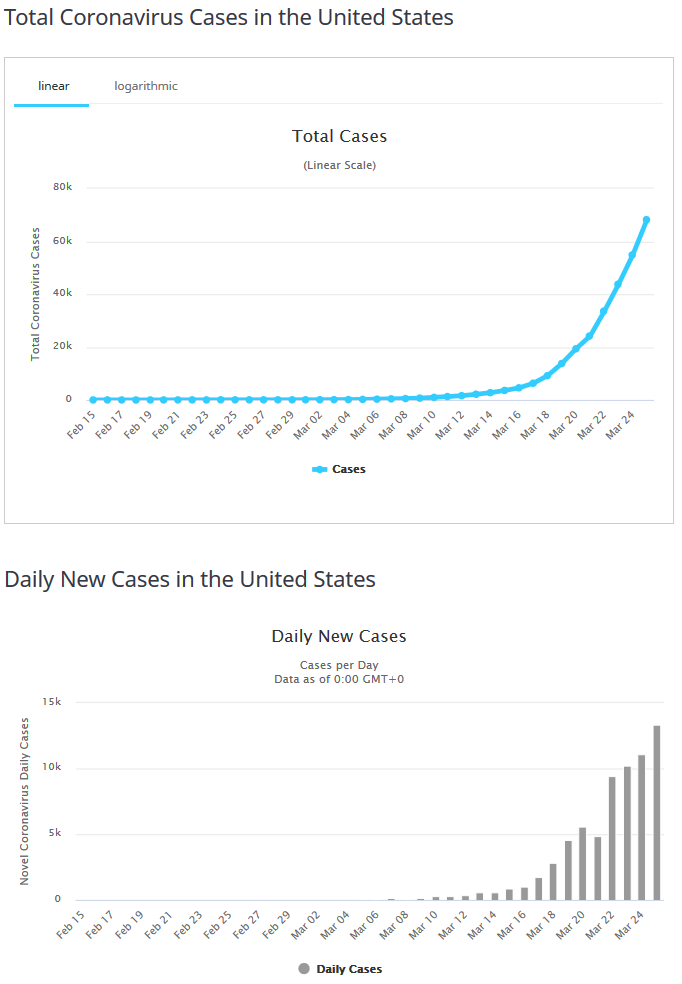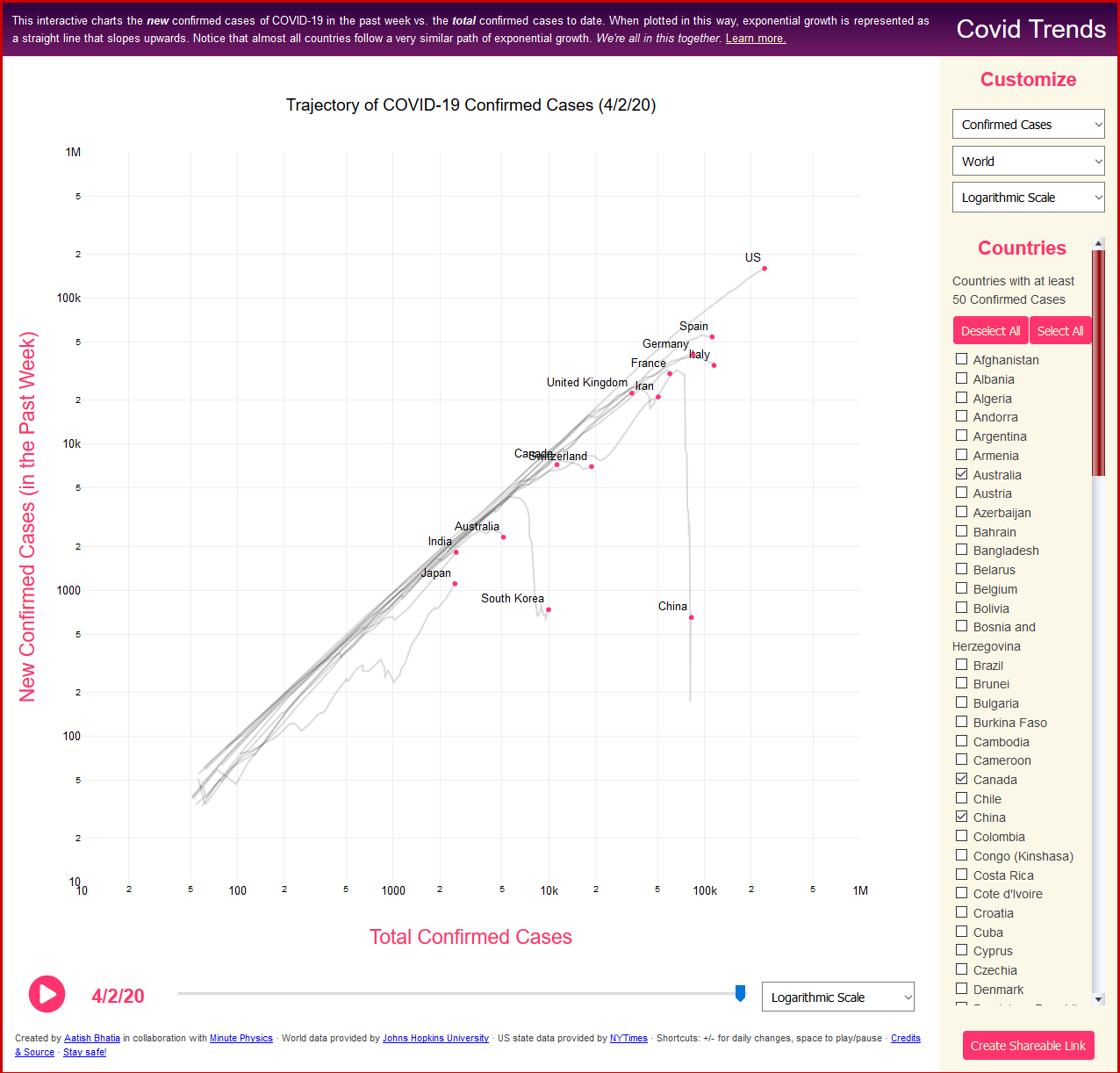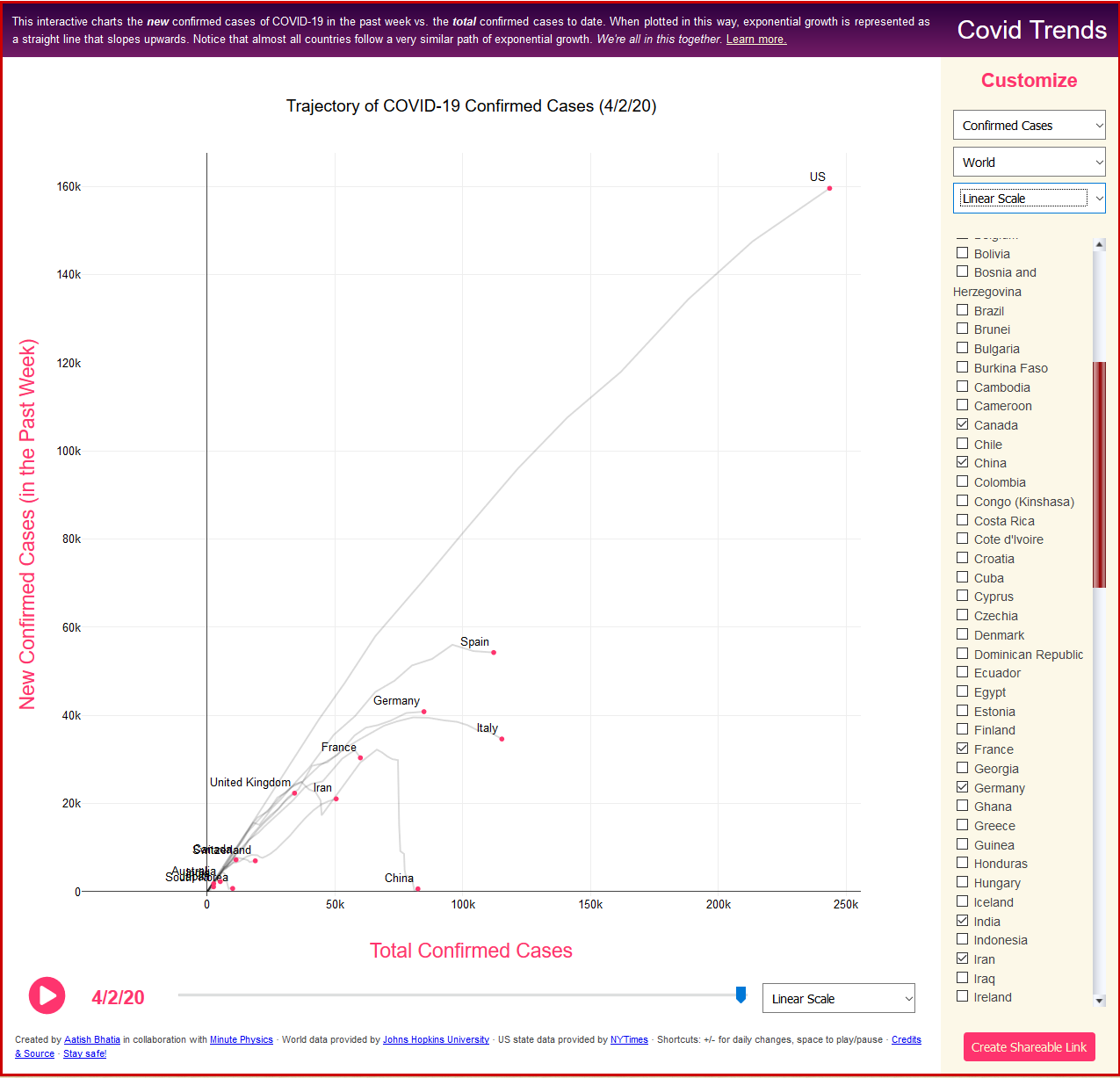A few hours ago, the WHO formally designated the novel coronavirus a pandemic. For a full account of this declaration, see WHO declares coronavirus a pandemic, citing ‘alarming levels of spread and … alarming levels of inaction’ .
For many people, it is a bit confusing why the coronavirus, which so far has infected far fewer people the annual seasonal flu and caused far fewer deaths, is being taken so much more seriously than the flu. For example, here in the US, the CDC estimates that for this year's partial flu season, running from October 1, 2019, through February 29, 2020, there have been between 34 and 49 million cases of the flu, and between 20 and 50 thousands flu deaths. When contrasted with the current number coronavirus cases, which is 1275 as of this writing, and the number of coronavirus deaths, which is 37, there seems to be no comparison; there are about 40 thousand times as many flu cases, and a thousand times as many flu deaths. Why is the coronavirus causing so much more concern than the flu?
The answer is manifold. First, so much about the coronavirus is still unknown, or only tentatively known. An excellent survey of these unknowns can be found in the article The unknowns of the coronavirus nearing a pandemic.
Second, the long-term responses of countries around the world is unknown and hard to predict. The way countries respond to this pandemic will have a huge effect on how severe it becomes.
Third, there is no vaccine for the novel coronavirus, and large-scale production of such a vaccine is at least 12 to 18 months away.
In light of this situation, exponential growth of the number of cases of the virus can be expected either until the virus is brought under control by massive governmental efforts and possibly the release of a vaccine, or until a large proportion of the population has been infected. The latter case, which is near the worst case on the spectrum, is what happened in the 1918 influenza pandemic (the Spanish flu), which infected about half a billion people, or about 27% of the world's population, and which caused an estimated 50 million deaths. It is useful to remember that the current world population is about four times the size of the 1918 population. Also, travel both internationally and within countries is far more prevalent today for the general population than it was in 1918. It is for this reason that German Chancellor Angela Merkel has warned that up to 70% of the country's population could contract the coronavirus; similar percentages could well apply in large numbers of countries.
How does exponential growth work, specifically in the case of viral spreading, what factors influence it, and what are the upper and lower bounds predicted by such growth? Also, what affects the rate of exponential growth? I have found the following video to be extremely helpful in answering these questions. Only a grade-school knowledge of math is required to understand it; no knowledge of exponential growth is required. Here it is:
I have found that the information gleaned from this video can be combined with current coronavirus statistics to get a good idea of where things are headed in the near future. The sources I have found useful for coronavirus statistics are Coronavirus Update (Live), which presents worldwide coronavirus data updated in real time, as well as broken down by country; Coronavirus Cases: Statistics and Charts, which gives a more detailed breakdown on the worldwide situation; and the individual country pages referenced in the first link in this paragraph, such as United States Coronavirus, which supplies detailed statistics for a given country. (Only a mall number of countries have their own pages.) On the US page, in figures such as "Total Coronavirus Cases in the United States" and "Daily New Cases in the United States", the shape of an exponential curve can clearly be seen, especially in the last week. This exponential growth can most easily be seen in countries with larger numbers of cases that have reliable reporting. It's not clear how reliable the reporting from China is.
I am posting this not in any attempt to create alarm, but rather to give people time to make plans for dealing with this virus, especially if governmental efforts fall short (as the WHO announcement indicated it believed was happening). We really don't know for sure what the effect of the coronavirus on PWME will be, but by all indications, we can expect to be on the more severe end of the range of reactions. Fortunately, a lot of us who are most at risk have been effectively self-quarantining for quite a while (though not by choice), and many of us have also learned how to avoid infection-spreading contacts, which can be quite dangerous for us just on a normal level. Combining these practices with frequent and thorough hand washing can go a long way toward minimizing our chances of acquiring this virus, which has a high mortality rate among people in poor health. Although no coronavirus cases have been identified within a hundred miles of me, they will come, and I have been preparing myself by assuming that everyone I come in contact with has the virus. I have found this to be very helpful in developing habits that will prove useful when the virus eventually makes its way down to this part of Oregon.
Good luck to everyone in dealing with this situation!
For many people, it is a bit confusing why the coronavirus, which so far has infected far fewer people the annual seasonal flu and caused far fewer deaths, is being taken so much more seriously than the flu. For example, here in the US, the CDC estimates that for this year's partial flu season, running from October 1, 2019, through February 29, 2020, there have been between 34 and 49 million cases of the flu, and between 20 and 50 thousands flu deaths. When contrasted with the current number coronavirus cases, which is 1275 as of this writing, and the number of coronavirus deaths, which is 37, there seems to be no comparison; there are about 40 thousand times as many flu cases, and a thousand times as many flu deaths. Why is the coronavirus causing so much more concern than the flu?
The answer is manifold. First, so much about the coronavirus is still unknown, or only tentatively known. An excellent survey of these unknowns can be found in the article The unknowns of the coronavirus nearing a pandemic.
Second, the long-term responses of countries around the world is unknown and hard to predict. The way countries respond to this pandemic will have a huge effect on how severe it becomes.
Third, there is no vaccine for the novel coronavirus, and large-scale production of such a vaccine is at least 12 to 18 months away.
In light of this situation, exponential growth of the number of cases of the virus can be expected either until the virus is brought under control by massive governmental efforts and possibly the release of a vaccine, or until a large proportion of the population has been infected. The latter case, which is near the worst case on the spectrum, is what happened in the 1918 influenza pandemic (the Spanish flu), which infected about half a billion people, or about 27% of the world's population, and which caused an estimated 50 million deaths. It is useful to remember that the current world population is about four times the size of the 1918 population. Also, travel both internationally and within countries is far more prevalent today for the general population than it was in 1918. It is for this reason that German Chancellor Angela Merkel has warned that up to 70% of the country's population could contract the coronavirus; similar percentages could well apply in large numbers of countries.
How does exponential growth work, specifically in the case of viral spreading, what factors influence it, and what are the upper and lower bounds predicted by such growth? Also, what affects the rate of exponential growth? I have found the following video to be extremely helpful in answering these questions. Only a grade-school knowledge of math is required to understand it; no knowledge of exponential growth is required. Here it is:
I have found that the information gleaned from this video can be combined with current coronavirus statistics to get a good idea of where things are headed in the near future. The sources I have found useful for coronavirus statistics are Coronavirus Update (Live), which presents worldwide coronavirus data updated in real time, as well as broken down by country; Coronavirus Cases: Statistics and Charts, which gives a more detailed breakdown on the worldwide situation; and the individual country pages referenced in the first link in this paragraph, such as United States Coronavirus, which supplies detailed statistics for a given country. (Only a mall number of countries have their own pages.) On the US page, in figures such as "Total Coronavirus Cases in the United States" and "Daily New Cases in the United States", the shape of an exponential curve can clearly be seen, especially in the last week. This exponential growth can most easily be seen in countries with larger numbers of cases that have reliable reporting. It's not clear how reliable the reporting from China is.
I am posting this not in any attempt to create alarm, but rather to give people time to make plans for dealing with this virus, especially if governmental efforts fall short (as the WHO announcement indicated it believed was happening). We really don't know for sure what the effect of the coronavirus on PWME will be, but by all indications, we can expect to be on the more severe end of the range of reactions. Fortunately, a lot of us who are most at risk have been effectively self-quarantining for quite a while (though not by choice), and many of us have also learned how to avoid infection-spreading contacts, which can be quite dangerous for us just on a normal level. Combining these practices with frequent and thorough hand washing can go a long way toward minimizing our chances of acquiring this virus, which has a high mortality rate among people in poor health. Although no coronavirus cases have been identified within a hundred miles of me, they will come, and I have been preparing myself by assuming that everyone I come in contact with has the virus. I have found this to be very helpful in developing habits that will prove useful when the virus eventually makes its way down to this part of Oregon.
Good luck to everyone in dealing with this situation!







